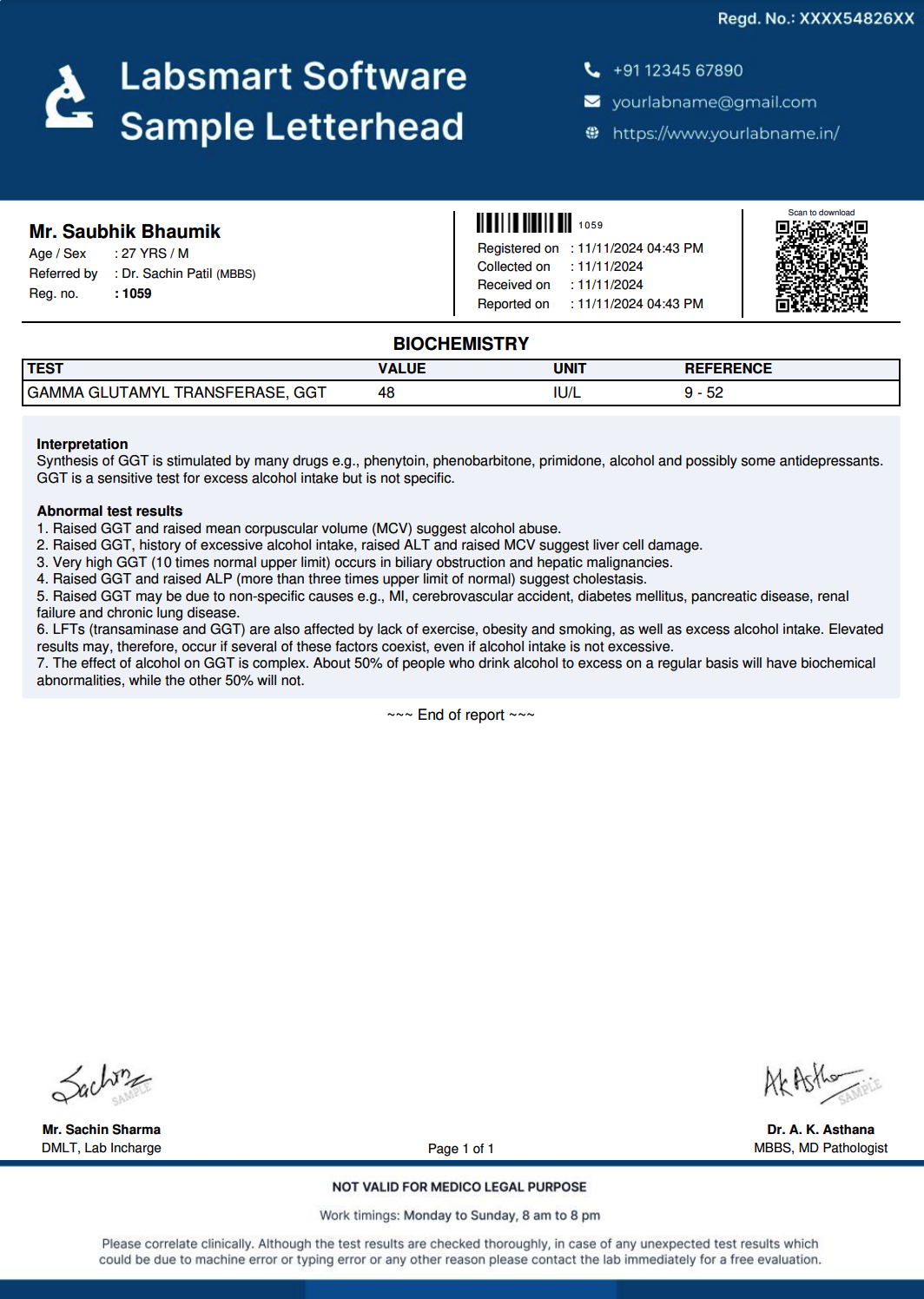What is Gamma Glutamyl Transferase, GGT ?
The Gamma Glutamyl Transferase (GGT) test measures the level of GGT, an enzyme found in the liver, bile ducts, and kidneys. GGT plays a key role in breaking down and metabolizing glutathione, a molecule involved in the detoxification process. Elevated levels of GGT can indicate liver disease or bile duct dysfunction. Clinicians may order a GGT test to: Assess liver function: GGT is a sensitive marker for liver damage. Elevated levels may indicate liver conditions like hepatitis, cirrhosis, or liver cancer. Evaluate bile duct issues: High GGT levels are often seen in conditions affecting the bile ducts, such as cholestasis (bile flow obstruction) or gallstones. Monitor alcohol use or abuse: GGT levels can be elevated due to chronic alcohol consumption or alcohol-induced liver damage. It is often used to assess alcohol-related liver disease or monitor alcohol abuse. Check for drug-induced liver damage: Certain medications, including anticonvulsants, statins, and antibiotics, can affect the liver and increase GGT levels. This test helps assess the impact of medication on liver health. Detect pancreatitis: Elevated GGT levels can also be linked to acute or chronic pancreatitis, as the enzyme is present in the pancreas as well.
Gamma Glutamyl Transferase, GGT Report Format: Breakdown
Here’s what an ideal Gamma Glutamyl Transferase, GGT report format should include:
Header Information:
- Patient Details: Full name, Age, Gender, and ID.
- TAT information: Timestamp for both sample collection and report generation.
- Doctor's Information: Name of the referral doctor, if applicable.
Test Results Section:
-
Patient's results
As obvious as it is, a test report should definitely have the patient's test result.
-
Result's Unit
The unit of the test result must be mentioned correctly in the report. Gamma Glutamyl Transferase, GGT test is generally reported in “IU/L”
-
Gamma Glutamyl Transferase, GGT Normal Value / Reference Range
The report must have the normal Gamma Glutamyl Transferase, GGT range. It can differ slightly based on the reagents used by the lab and other internal factors, but common Gamma Glutamyl Transferase, GGT ranges are:
9 - 52
Interpretations
Nowadays, most labs prefer to add interpretations to the reports, making the report more patient-friendly. Labsmart software has interpretations of all routine test pre-filled in the software.
Footer Section:
-
Certifications:
Display any relevant accreditations (e.g., NABL, ISO), adding to your lab's credibility.
-
Pathologist and technician signature:
It's mandatory to add a Pathologist and technician signature to the report.
GGT Interpretation
In Labsmart software, this is the inbuilt interpretation for Gamma Glutamyl Transferase, GGT
Importance of adding interpretation to reports:
It's very helpful to add interpretation in reports as it makes the reports more patient friendly and also helpful to doctors in some cases. Moreover, presently most labs prefer providing reports with interpretation. Thus, adding interpretation to report will help your lab stay at par with other competitor labs.
Labsmart software
(With Interpretation and auto calculations)
- Billing
- Reports with Interpretation
- Auto calculation where needed
- Check daily business
- WhatsApp reports
* Free plan available

1.5 Crore+
Reports printed & delivered online
1250+
Labs Active
10+
Countries
GGT MS Word format
Download the Ms word editable Gamma Glutamyl Transferase, GGT report format for offline reporting.
Download word format





